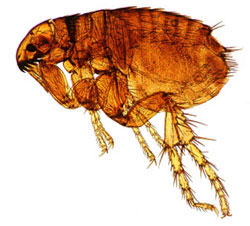Fleas
Fleas are small, wingless insects. When viewed from the front, head on, the adult flea’s body is narrow from side to side. This allows it to move readily between hairs in the animals fur. Adult fleas have piercing, sucking mouth parts to penetrate the skin of the host and suck blood. Their long powerful legs permit them to jump as high as seven to eight inches vertically and as far as 14 to 16 inches horizontally. Fleas have a complete metamorphosis.
The smooth, rounded white colored eggs are about 1/50 of an inch in diameter, only large enough to be barely seen. Since flea eggs are not attached to the host, the female flea will lay a few eggs each day until she has laid up to 200 to 400. Depending on the temperature and humidity, these eggs will hatch in anywhere from two days to a week, but most will hatch within two to three days under favorable conditions. Flea larvae are small, active, maggot-like creatures. Each has 13 body segments and chewing mouth parts, but no legs. They feed on all types of organic debris and develop particularly well when they can feed on the feces of adult fleas which contains undigested or partially digested blood. The larva grows through three instars in about one week or up to several months depending on environmental conditions and food availability. These larvae are rarely seen by the homeowner unless a very close and thorough inspection is made. The mature larva spins a cocoon for pupation. If temperatures are favorable (greater than 70° F), within about 7 to 10 days the adult flea develops within the cocoon, but the adult may not emerge immediately.
Many adult fleas emerge from the cocoon within 7 to 14 days after the cocoon is formed, but some will remain in a pre-emerged adult state within the cocoon from which they may not emerge for several months to a year later. Warmth and mechanical signals (such as the weight of a pet’s paw actually stepping on the cocoon) will trigger emergence. This phenomena helps explain the situation where vacationers, or people who move into a new home or apartment are besieged by hungry fleas within a few hours after returning to their home or moving into new premises. Hungry adult fleas may have been present for some time in the premises.
 Many may have been stimulated to emerge from cocoons by the sudden presence of host animals or people. Adults are ready to feed and mate very soon after they emerge from the pupal cocoon. Fleas will generally be concentrated in pet resting areas outdoors because the substrate in such areas will receive a fallout of fecal material (containing blood for the larvae to feed on) from the adult fleas feeding on the pet. Fleas are know as being carriers of parasites or disease organisms.
Many may have been stimulated to emerge from cocoons by the sudden presence of host animals or people. Adults are ready to feed and mate very soon after they emerge from the pupal cocoon. Fleas will generally be concentrated in pet resting areas outdoors because the substrate in such areas will receive a fallout of fecal material (containing blood for the larvae to feed on) from the adult fleas feeding on the pet. Fleas are know as being carriers of parasites or disease organisms.
Customer preparation is required prior to beginning flea treatment. Click Here for a Printable Checklist.
